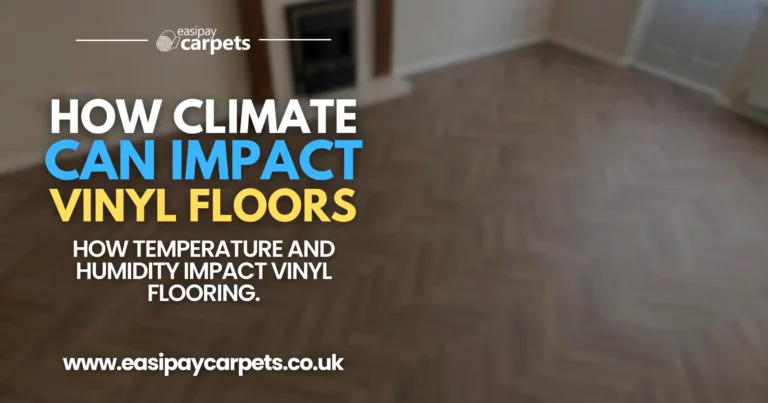

How Climate Impacts Vinyl Flooring
While vinyl flooring is a popular choice for its durability, affordability, and aesthetic appeal, different climate conditions can significantly affect its performance and longevity. Understanding these impacts can help you make informed decisions and ensure your vinyl floors stay beautiful and functional for years to come. Let’s dive in!
Understanding Vinyl Flooring
What is Vinyl Flooring?
Vinyl flooring is a versatile and popular choice for many reasons:
- Durability: It can withstand heavy foot traffic and resist scratches and stains.
- Affordability: It offers a cost-effective alternative to more expensive flooring materials.
- Aesthetic Variety: Available in numerous styles, colours, and patterns, vinyl can mimic the look of wood, stone, and other high-end materials.
Types of Vinyl Flooring
There are two main types of vinyl flooring:
- Sheet Vinyl: Comes in large, continuous sheets and is often used in areas that require waterproof flooring.
- Luxury Vinyl Tile (LVT): Comes in tiles or planks, offering a more luxurious appearance and easier installation.
How Climate Impacts Vinyl Flooring
Temperature Fluctuations
Expansion and Contraction
Vinyl flooring can expand and contract with temperature changes. This is especially true in climates with extreme temperature fluctuations between seasons.
- Hot Weather: High temperatures can cause vinyl flooring to expand. If there isn’t enough space for expansion, the flooring can buckle or warp.
- Cold Weather: Low temperatures can cause vinyl flooring to contract, leading to gaps between planks or tiles.
Solutions:
- Proper Installation: Ensure that there is an adequate expansion gap around the perimeter of the room during installation to allow for natural movement.
- Climate Control: Maintain a consistent indoor temperature using heating and cooling systems to minimize extreme fluctuations.
Humidity and Moisture
Warping and Buckling
High humidity levels can cause vinyl flooring to absorb moisture, leading to warping, buckling, or mould growth. Conversely, extremely low humidity can dry out the vinyl, making it brittle and more prone to cracking.
Solutions:
- Dehumidifiers and Humidifiers: Use dehumidifiers in humid climates and humidifiers in dry climates to maintain optimal indoor humidity levels (ideally between 35-50%).
- Proper Sealing: Ensure that seams and edges are well-sealed to prevent moisture from seeping into the subfloor.
UV Exposure
Fading and Discoloration
Prolonged exposure to direct sunlight can cause vinyl flooring to fade and discolour over time, especially in sunny or hot climates.
Solutions:
- Window Treatments: Use curtains, blinds, or UV-protective window films to protect your vinyl flooring from direct sunlight.
- Move Furniture and Rugs: Periodically move furniture and rugs to ensure even exposure and prevent uneven fading.
Cold Climates
Brittle and Cracking Vinyl
In extremely cold climates, vinyl flooring can become brittle and more susceptible to cracking. This is particularly true if the flooring is not acclimated properly before installation.
Solutions:
- Acclimation: Allow the vinyl flooring to acclimate to the room’s temperature for at least 48 hours before installation.
- Insulation: Ensure the subfloor is properly insulated to protect the vinyl from extreme cold.
Best Practices for Different Climates
Hot and Humid Climates
Recommendations:
- High-Quality Adhesives: Use adhesives that are specifically designed for high humidity to prevent flooring from lifting.
- Moisture Barriers: Install moisture barriers under the vinyl flooring to prevent moisture-related issues.
Cold and Dry Climates
Recommendations:
- Flexible Vinyl Products: Choose vinyl flooring products that are designed to remain flexible in low temperatures.
- Radiant Heating: Consider installing radiant heating under the vinyl flooring to maintain a consistent temperature.
Temperate Climates
Recommendations:
- Standard Maintenance: Regular cleaning and maintenance should suffice, but still be mindful of seasonal humidity changes.
- Consistent Indoor Climate: Use climate control systems to maintain a stable indoor environment.
Maintaining Vinyl Flooring in Various Climates
Regular Cleaning
Tips:
- Sweep or Vacuum: Regularly remove dirt and debris to prevent scratches.
- Damp Mop: Use a damp mop with a mild cleaner specifically designed for vinyl flooring.
Addressing Spills and Stains
Tips:
- Immediate Clean-up: Wipe up spills as soon as they occur to prevent staining and water damage.
- Use Appropriate Cleaners: Avoid harsh chemicals and use cleaners recommended by the manufacturer.
Periodic Inspections
Tips:
- Check for Damage: Regularly inspect your vinyl flooring for signs of damage, such as warping, buckling, or gaps.
- Prompt Repairs: Address any issues promptly to prevent further damage.
Additional Tips for Long-Lasting Vinyl Flooring
Use Furniture Pads
- Protect the Floor: Attach felt pads to the legs of furniture to prevent scratches and scuffs when moving items around.
Avoid Sharp Objects
- Prevent Damage: Be cautious with sharp objects that can cut or gouge the vinyl flooring.
Rotate Rugs and Mats
- Even Exposure: Periodically rotate rugs and mats to ensure even wear and prevent uneven fading from sunlight.
Further Reading
For those of you who love diving deep into home improvement and flooring care tips, here are some fantastic resources:
We hope this guide helps you understand how climate impacts vinyl flooring and provides you with the knowledge to maintain your floors in any climate.
Easipay Carpets can help you get brand new flooring without the high up-front cost – by simply letting you spread the cost of the flooring over time instead. There’s no interest on our plans so you aren’t spending a penny more than you would buying it outright and we include underlay, door trims, carpet grippers and laminate beading for free. Prices start from just £10 per week!
It starts with a free home appointment and quote, to get booked in at a time that suits you, tap the “Get Started” button below and fill out the contact form!




